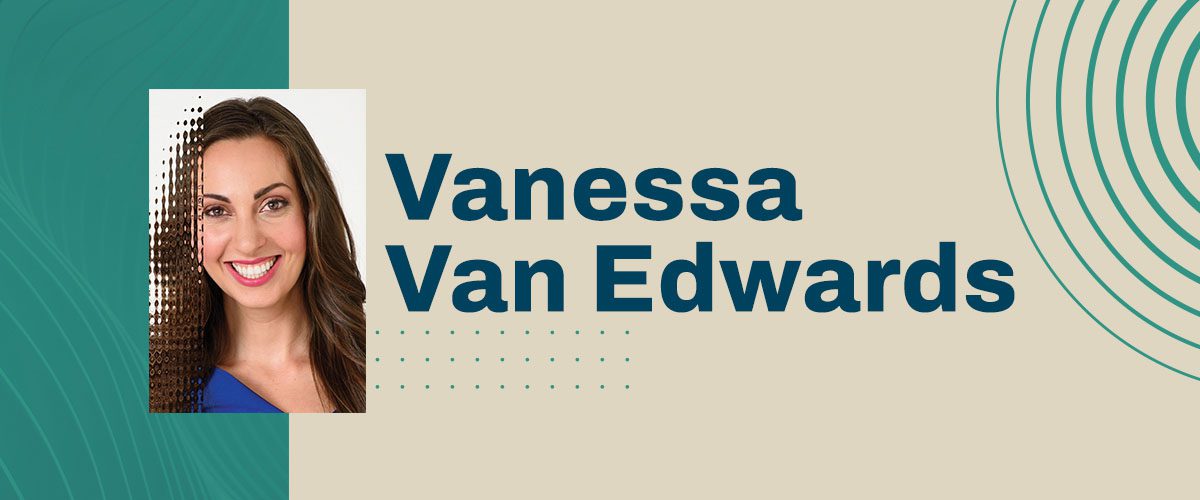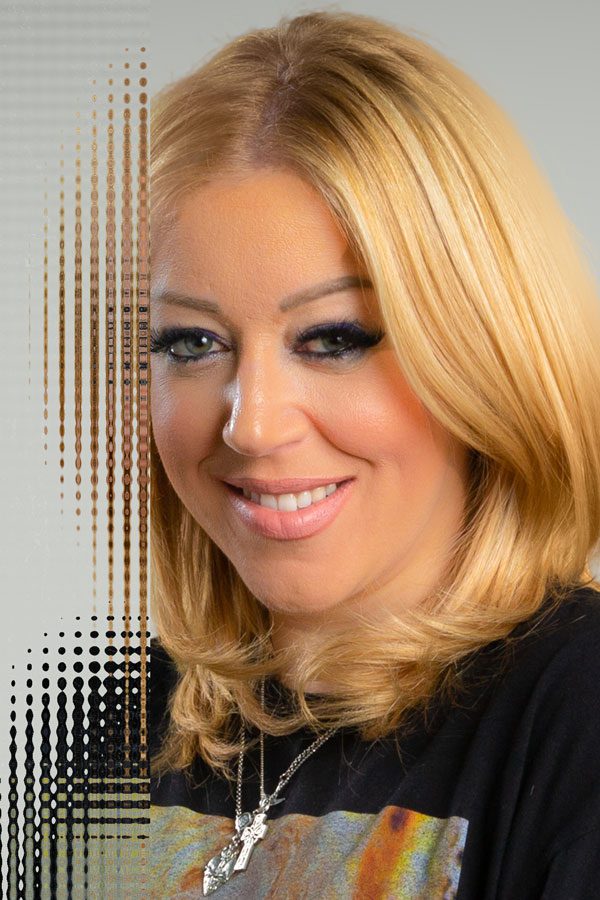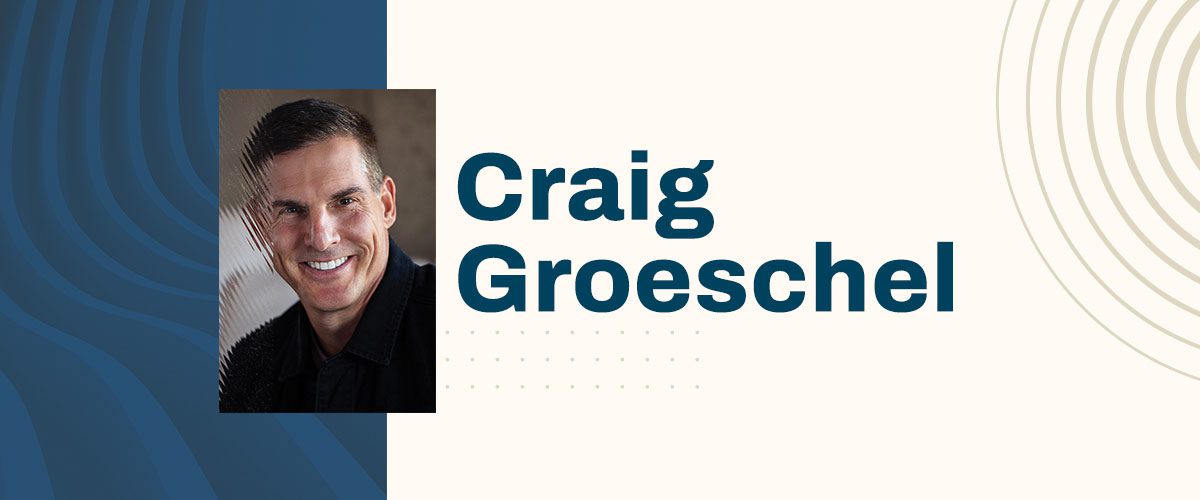
As a leader navigating the daily whirlwind of conversations, agendas, and goals, how do you more deeply and authentically connect with those around you? Vanessa Van Edwards, Founder and Lead Behavioral Investigator of Science of People and national best-selling author of Captivate: The Science of Succeeding With People, is a master of this topic! Over 36 million people have seen her on YouTube and in her viral TED Talk. And for over a decade, Vanessa has been leading corporate trainings and workshops to audiences around the world, including SXSW, and MIT, and at companies including Google, Dove, Microsoft, and Comcast.
During her talk at The Global Leadership Summit coming up in August 2022, Vanessa will explore three levels of connection and how you can use masterful conversation strategies to unlock deeper levels of trust with the people around you. Building these connections will help you utilize the relational strength of your team (or your family) to accomplish the great mission ahead of you. Get Tickets >>
Until then, get a preview of Vanessa’s insights on The Global Leadership Podcast, where she was interviewed by President & CEO of the Global Leadership Network, Tom De Vries on how to cultivate leadership charisma. In this interview, she dives into some of the content from her brand-new book, Cues: Master the Secret Language of Charismatic Communication.
Social Cues that Communicate Charisma
As a self-proclaimed “recovering awkward person” Vanessa shares how she found clarity in the realization that there is an invisible language being spoken all around us. “It felt like somehow I had missed the memo on all the cues people were sending back and forth,” says Vanessa. “So, I wanted to set out to see if there was a way to code the cues we send to each other with our body, our face, our voice, our words—and could we learn to leverage them to help us with our communication, to make our communication a little easier?”
Vanessa defines these cues as powerful social signals that we send to each other. These can be verbal, nonverbal, facial, or vocal. Together, the balance of warm and competent cues communicates our charisma, the critical characteristic people respond to or are drawn to. “What’s really interesting is when we talk about cues, we forget that these are the ways we interpret people’s impressions of us,” Vanessa explains. “When we show up in an interaction, someone is very quickly looking at our cues, and deciphering our cues to figure out how charismatic they are. I used to think you had to be born with charisma. I thought there’s no way it could be learned. The good news is that the research says cues and charisma can be learned.”
Bad Guy Cues Vs. Good Guy Cues
As Vanessa began doing her research on cues, she started to notice two types—bad guy cues, and good guy cues. Bad guy cues are cues of guilt, deception, shame, sadness, and anger. “Bad guy cues were cues that leaked out when I saw celebrities lie on reality shows,” Vanessa shares. “Back in the day, Lance Armstrong went on Larry King and said, no, no, he was not doping. Spoiler alert. Lance Armstrong was doping. I remember watching that interview and thinking something is not right. I coded a couple of these very small cues he did. I’ll give you an example. One of the cues he did in that interview is what’s called a lip purse. This is a universal withholding cue. When we’re trying to hold something back or hold something in, we mash our lips together. In this interview he was asked, have you doped? And he mashed his lips together and said, no, absolutely not.”
Research found that highly charismatic people have a perfect blend of two traits—they are both warm and competent
For the good guy cues, she noticed extremely charismatic people had similar nonverbal, verbal, and vocal cues they were using repeatedly that made them captivating and compelling people you wanted to keep listening to. “Research found that highly charismatic people have a perfect blend of two traits—they are both warm and competent,” Vanessa explains. “What’s key about this is they must have a balance of both. For example, high warmth, trust, collaboration, balanced with high competence, capability, and effectiveness make us feel like we can both trust and rely on someone. Highly compelling people are constantly sending off cues that say, you can trust me, you can rely on me.”
The Crux of Miscommunication—Imbalance
The problem is that most of us have an imbalance of warmth or competence, which ends up being a crux of our miscommunication, especially for leaders. “I think a lot of leaders accidentally end up trying to push too much warmth or too much competence without the balance,” says Vanessa. “You see a leader who shows up wanting to be trustworthy, likable, open, and collaborative. But the problem is if you don’t balance it out with enough competence cues, people don’t take you seriously. They see you as likable, but they also might see you as a people pleaser. They might see you as a pushover. They might see you as too agreeable. People who are highly warm are interrupted more and people forget having met them. Their high likability does not have enough of that competence to get people to take them seriously.”
On the other hand, a lot of smart people who might be high in competence find that their smarts can be their liability. “People who are high in competence want to hit you with their competence,” Vanessa explains. “They get out all their facts and tell you all these impressive things. They want to be memorable. But the problem is if you’re too high in competence without enough warmth, you’re seen as intimidating, hard to talk, or cold. People take you very seriously, but they don’t open up to you. They withhold information from you. They’re afraid to work with you on a team.”
Balance between warmth and competence is needed to lead with the charisma that motivates people.
Both Extroverts & Introverts Can Be Charismatic
One idea many of us misunderstand is the stereotype around charismatic leaders being extroverts. According to Vanessa’s research, she has found that both introverted and extroverted leaders can be charismatic leaders. “I’m not an extrovert and I worried, am I going to have to pretend to be an extrovert to be charismatic?” Vanessa shares. “But what the research shows is very clear. Yes, we can have the bubbly extrovert, life of the party. That is a kind of charisma. But there’s also the quiet, contemplative, powerful introvert that is charismatic. There’s also that empathetic, compassionate healer that is charismatic. So, my goal is to make sure people realize there are different flavors on the charisma scale, and how you mix the ingredients of warmth and competence.”
I’m not an extrovert and I worried, am I going to have to pretend to be an extrovert to be charismatic?
In her new book, Vanessa talks about how we can learn to balance between warm and competent cues and use them like a thermostat. “These cues are not just nice to have, they are need to have—they’re affecting how we think, how we feel, and how we behave,” Vanessa shares. In fact, in their research they explored cues of social rejection, where if someone walked into a room with an eyeroll or a scoff, people responded by increasing their field of vision. “Literally, our eyes change shape so we can see more of our environment,” Vanessa exclaims. “That’s because our brain immediately says, wait a minute, are there other cues of social rejection? What’s my escape route? What should I do next?”
On the other hand, if you send others warm cues, you are more likely to trigger feelings of warmth. “It’s actually being contagious in a positive way,” says Vanessa. “It’s infecting people with the exact cues they need to be charismatic as well. If you want your team to be more collaborative, you can inspire collaboration. If you want your team to be more productive, you can inspire productivity.”
High Competence Vs. High Warmth
You know you’re high in competence if you’ve ever been told that you’re intimidating or cold. “The biggest mistake a highly competent leader makes is believing that stoic equals powerful,” says Vanessa. “They believe that hiding, stifling, and suppressing all emotions and expressiveness is a way of being powerful. It could not be farther from the truth. It is true that highly skilled people are seen as powerful, but they’re also seen as cold. So, if you want to be highly powerful but also highly warm, avoid going mute. I don’t want you to be still and I don’t want you to stifle expressiveness. There is nothing worse than an ambivalent leader in the face of your excitement, or in the face of your worry.
The biggest mistake a highly competent leader makes is believing that stoic equals powerful
On the other hand, highly warm people can be so focused on relating that they can’t be efficient. “I want us to be able to both relate and be efficient,” says Vanessa. “Highly warm people tend to accidentally give off nonverbal signals of relatability, which is great for a little bit of warmth. But if you’re trying to get things done, it will go against your goal. The number one cue I want my highly warm people to avoid is bobble heading.”
Vanessa has discovered that nodding encourages others to speak three to four times longer. She explains that the reason you might not be able to get things done is because you’re nodding, and the other person keeps going. “Highly warm people, nod, and nod, and nod. They’re always nodding. Nodding is a highly warm cue. The problem is that it’s a highlighter, meaning it should emphasize a single point or a single idea. If I were to highlight an entire page of text, it disappears. The entire thing looks important. If I highlight one phrase, it brings up that one phrase. So, I want you to think of nodding like a condiment. So, you are still except when someone says something good that you really agree with, that you really want to encourage. Then you can give a slow, triple nod.”
Vocal Cues that Indicate a Lie
Vanessa explains that as we have more video calls, and as we’re on the phone more, we must be extremely aware of our vocal cues and the information they give to others. In her lab, Vanessa’s team does a lot of research on lie detection. In one study, they had people play two truths and a lie. Then they tried to code what each person did differently on the lie.
“We found that vocal cues were the easiest way to detect the lie,” says Vanessa. “We were more accurate at guessing which was the lie if we didn’t look at the video—the video was distracting. That’s because there are a couple of things liars do. Liars typically asked their lie. They used the question inflection on their lie. A misplaced question inflection is when we ask a statement—we go up at the end of our sentence. Liars are often asking their lie because they’re asking, do you believe me? If you have an announcement, or you have an idea you want to share, don’t ask it. You give away all your vocal power when you present with a question inflexion. Say your statements. Ask your question.”
Being Authentic
Vanessa closed the conversation with a word about authenticity, and how cues can be used to manipulate, but her hope is that people develop their skills around cues to become more of their authentic selves in service for the good of others. “Authenticity is one of my favorite words,” says Vanessa. “I do not believe in fake it ‘til you make it. I do not believe that we have to pretend to be something we’re not to be a leader. I do not think that we have to fake cues, feign competence, or pretend to be warmer and likable when we don’t actually feel it. In fact, I believe the opposite. I want to help people be their warmest, most competent self. Coming at every cue from the place of service and authenticity is how we’re going to be our most compelling, charismatic, and contagious selves.”
I do not believe that we have to pretend to be something we’re not to be a leader.
Want to build stronger connections with those around you? Hear more from Vanessa Van Edwards on the Science of Connection on August 4-5, 2022, at The Global Leadership Summit. Get Tickets >>


















 With a passion to partner with local leaders and be a catalyst for change, Norma and her daughter Amanda Hentges have been heavily involved in ministry work in the DR for a number of years. While visiting various projects they’re involved with in the DR, Norma and Amanda started to wonder about how young women managed their cycles to stay in school. With open hearts to God’s leading, they went on a journey to help bring the Days For Girls project to the DR.
With a passion to partner with local leaders and be a catalyst for change, Norma and her daughter Amanda Hentges have been heavily involved in ministry work in the DR for a number of years. While visiting various projects they’re involved with in the DR, Norma and Amanda started to wonder about how young women managed their cycles to stay in school. With open hearts to God’s leading, they went on a journey to help bring the Days For Girls project to the DR. Graeme and Claudybel are also heavily involved in ministry work in the DR. Now living in Canada, Claudybel is originally from the DR, and remains connected to her home country through family and various programs she and her husband support, now including the Days For Girls DR project.
Graeme and Claudybel are also heavily involved in ministry work in the DR. Now living in Canada, Claudybel is originally from the DR, and remains connected to her home country through family and various programs she and her husband support, now including the Days For Girls DR project. Not long thereafter, they brought Carlos to Canada to spend the day with Celeste, and together they envisioned what it might look like to reach all the girls ages 13-18 with women’s health education and Days For Girls health kits. “When I met Carlos, I got a sense that he would be an amazing partner,” said Norma. “My goal is to be a catalyst between philanthropic funders and charitable endeavors. I sensed in Carlos that he was also catalyst leader. I remember asking him, ‘Carlos, all these goals we have, how are we going to do it?’ And he said, ‘Norma, I have people.’ Carlos is the real deal! He has people, and we’re all a part of it. As a community, we’re not scared to try something big.”
Not long thereafter, they brought Carlos to Canada to spend the day with Celeste, and together they envisioned what it might look like to reach all the girls ages 13-18 with women’s health education and Days For Girls health kits. “When I met Carlos, I got a sense that he would be an amazing partner,” said Norma. “My goal is to be a catalyst between philanthropic funders and charitable endeavors. I sensed in Carlos that he was also catalyst leader. I remember asking him, ‘Carlos, all these goals we have, how are we going to do it?’ And he said, ‘Norma, I have people.’ Carlos is the real deal! He has people, and we’re all a part of it. As a community, we’re not scared to try something big.”

Recent Comments